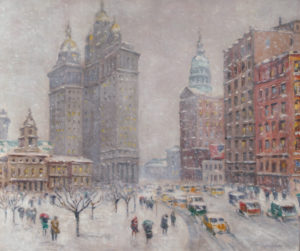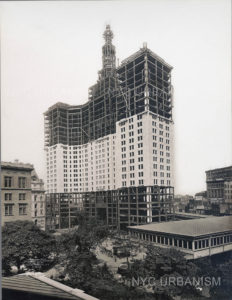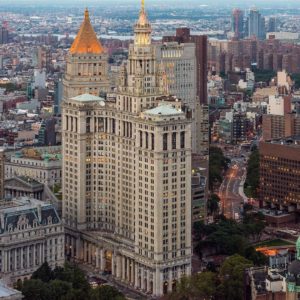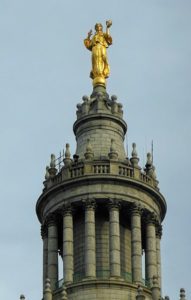This week we’re taking a look at one of New York City’s early skyscrapers through the work of Guy Carleton Wiggins.
Wiggins’ City Hall Park captures a vantage point from the south end of the park. In the foreground to the left, we see City Hall – the seat of NYC government and the oldest city hall building in the US that still houses governmental functions. Then on the right of the composition, we see notable historic structures like the original New York Times Building and the Potter Building, which housed Joseph Pulitzer’s New York World newspaper at the turn of the 20th century. But in the distance, towering over all the others, sits the Manhattan Municipal Building. The sprawling 40-story structure has about 1 million square feet of space, making it one of the largest government buildings in the world… not to mention it’s adorned with America’s first supermodel!
By the late 1800s, NYC’s government had outgrown City Hall. Various government agencies started renting space from surrounding buildings, but it quickly became unmanageable. In 1885, a team was created to look for plots of land for a single government building. They hosted several design competitions, but plan after plan was scrapped; the process dragged on for decades. It wasn’t until 1907 that things would truly begin moving forward – the city hosted their 4th competition, inviting thirteen notable architects to submit plans.
The panel ultimately chose McKim, Mead & White. They were of the most prominent architects of their time… responsible for building The Washington Arch in Washington Square Park (1892), Columbia University (1893-1900), The Brooklyn Museum (1895), Penn Station (1904), and dozens of other significant structures throughout the city. Today, they are regarded as one of the most influential firms in American architecture and a leader of the American Renaissance.
Construction began here in July of 1909 and took about 5 years, with a total cost of $12 million (equivalent to more than $230 million today). By the time of completion, it was expected to save the city roughly $800K per year in rent… that said, the debt taken on to pay for it wouldn’t be repaid for 50 years. In a half century, the $12 million accumulated more than $30 million in interest!
One notable feature stands atop the building – Civic Fame, a 25-foot tall statue created to celebrate the consolidation of the five boroughs into the City of New York. Model and actress Audrey Munson posed for the artist who created it… known as “Miss Manhattan” and “American Venus,” she appears in countless sculptures across the country, and is prominently placed in more than a dozen locations across NYC. From granite to gold, she graces courthouses, government buildings, monuments, and even the NY Public Library… but this one happens to be the largest of them all. In fact, it is the largest statue in the city, that is unless we’re including The Statue of Liberty.




